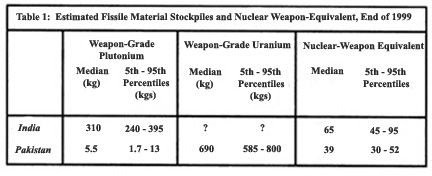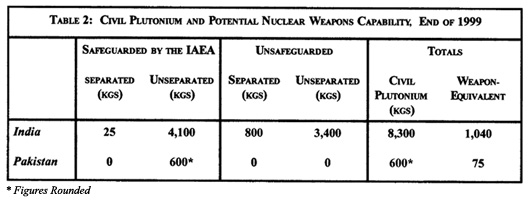

Estimating the size of India and Pakistan's inventory of separated weapon-grade plutonium and highly enriched uranium (HEU) has become more difficult following their nuclear tests in May 1998. Both countries treat these numbers as highly classified, partly because such estimates provide a direct indication of the number of nuclear weapons they may possess. The purpose of this annual report is to summarize estimates of their stocks of fissile material. This report is an update of a report covering the period up to the end of 1998.1
In the case of Pakistan, what can be surmised is that it has resumed full-scale production of HEU, following a declared moratorium on such production since 1991. Abdul Q. Khan, the father of Pakistan's uranium enrichment program, announced soon after the Pakistani tests that his country had never stopped making HEU. Although his comment has been greeted skeptically, it indicates that Pakistan may have resumed making weapon-grade uranium well before its tests in May 1998.
Exactly how long before the tests Pakistan resumed making weapon-grade uranium is not too important in these calculations. During its moratorium, Pakistan produced low enriched uranium (LEU), which can be up-graded to weapon-grade uranium relatively rapidly. Given the length of the moratorium, this stock of LEU was relatively large and would have enabled a rapid increase in Pakistan's stock of weapon-grade uranium.
In addition, in April 1998, Pakistan announced that the Khushab reactor had started operating.2 This reactor, estimated to produce about 50 megawatts of power, could make enough plutonium for a few nuclear weapons per year.
Although no reports have emerged publicly about the performance of the Khushab reactor, CBS News reported on March 16, 2000 that U.S. intelligence had found evidence that Pakistan is reprocessing irradiated, or "spent," fuel from the Khushab reactor and recovering separated plutonium.3
The CBS report says that the United States had detected significant krypton 85 emissions from a small reprocessing plant at Rawalpindi, located near Islamabad.4 The "New Labs" reprocessing plant, next to the Pakistan Institute of Nuclear Science and Technology (Pinstech), has been finished for over a decade. Nuclear Fuel reported that New Labs has been upgraded and expanded during the 1990s to handle all the irradiated fuel from the Khushab reactor.5
With regard to India, information suggests that it is trying to increase the size of its stock of weapon-grade plutonium and perhaps HEU. India may be considering using its civil power reactors to increase its stock of weapon-grade plutonium. In addition, the debate about whether one of the Indian tests used reactor-grade plutonium is unresolved, leaving unanswered whether India considers its civil unsafeguarded power reactors and their large associated plutonium stock, at least potentially, to be part of its nuclear weapons program.
Faced with a swirling mixture of solid and ambiguous information, a more sophisticated analytical approach has been used to estimate India's stock of weapon-grade plutonium and Pakistan's stock of weapon-grade uranium and weapon-grade plutonium. This new approach specifically aims to capture the varying and conflicting information about key parameters affecting estimates of the size of the inventories. Rather than decide on a best estimate of a specific parameter, such as lifetime reactor operating capacity, a distribution of possible values is derived. In this way, various choices can be assigned a probability of being true.
U.S. officials, for example, have recommended strongly that India's Cirus and Dhruva plutonium production reactors have a lifetime capacity factor of about 40 percent. Indian officials have stated that the average capacity factor is significantly greater, as large as 60 percent. In this estimate, the most likely choice is selected as 40 percent with values up to 60 percent having a diminished probability of occurring. On the other end, a lifetime capacity factor less than 30 percent is viewed as highly unlikely. In the case of Pakistan's total enrichment capacity at the Kahuta and the newer Gadwal facilities, a wide range of possible values is given equal probability of occurring.
Using Crystal BallTM software, distributions representing key parameters in the calculations are sampled using a "Monte Carlo" approach to derive a distribution of results. This method varies from previous approaches used by the author, where central or best estimates are derived, and an uncertainty is attached by making a judgement about the overall data and information.6 Although judgements are still necessary in any uncertainty analysis, they can be applied more credibly in this more sophisticated method.
India's inventory is derived by estimating total production of weapon-grade plutonium in the Cirus, Dhruva, and power reactors and by subtracting drawdowns from nuclear testing, processing losses, and civil uses of the weapon-grade plutonium. The median value, which is the value midway between the smallest and largest value, is about 310 kilograms of weapon-grade plutonium at the end of 1999.7 The range in the values can be understood by considering the set of all values, which in this case vary between 180 kilograms and 480 kilograms. Because values in the tails of the range carry a very low probability of being true, often only the values that fall between the 10th and 90th percentile are considered, which in this case are 250 kilograms and 375 kilograms, respectively. To be more certain that the actual value lies in the range, the 5th and 95th percentiles can be selected, which are 240 kilograms and 395 kilograms, respectively. One way to interpret the results is that, in the latter case, there is 90 percent certainty that the true value lies between 240 and 395 kilograms of weapon-grade plutonium, where the median value is about 310 kilograms (see table 1).

The amount of plutonium needed for a nuclear weapon is represented by a triangular distribution that varies from 3 to 7 kilograms with the most likely value at 4.5 kilograms. The number of nuclear weapons India may have made from its stock of weapon-grade plutonium is listed in table 1, where the median is 65 weapons and the 5th and 95th percentiles are 45 and 95 weapons, respectively. However, recent media accounts have cast doubt on estimates that assume India has used all its available weapon-grade plutonium in nuclear weapons. NBC reported, based on an unclassified U.S. Defense Department document dated November 23, 1999, that India probably has only a handful of nuclear bombs-interpreted by NBC as about five weapons-and India is conducting research into missile warhead design.8 Other published estimates, some dating to the mid-1990s, are that India has about 30 nuclear weapons. Regardless of the actual number, most analysts believe that India is rapidly expanding the number of its nuclear weapons.
India operates a small enrichment plant that can, in theory, make HEU, although the amount produced so far is unknown. In any case, this amount is believed to be relatively small and is ignored here.
Pakistan's inventory of weapon-grade uranium is derived by estimating several factors, including total enrichment capacity, the feedstock into the enrichment plant, and the amount of LEU produced in Pakistan during the 1990s. Drawdowns, mainly resulting from the 1998 nuclear tests, are then subtracted.
An important factor in this calculation is that, in 1998 and 1999, LEU, widely reported to have been produced during the HEU moratorium from 1991 to 1998, was up-graded in the enrichment plants to weapon-grade uranium. This significantly increases Pakistan's inventory of weapon-grade uranium. However, this rate of growth in the inventory cannot be sustained, because Pakistan would have likely run out of LEU in 1999. Table 1 (above) shows the results for weapon- grade uranium. The median value is 690 kilograms of weapon-grade uranium, and the 5th and 95th percentiles are 585 and 800 kilograms, respectively.
As mentioned above, Pakistan has started a reactor that can make weapon-grade plutonium. The amount of weapon-grade plutonium that has been produced and separated through the end of 1999 cannot be estimated precisely, although it is likely enough for a single nuclear explosive. Assuming that the reactor did not operate well during this period and that losses during separation were relatively large, the median estimate is 5.5 kilograms, and the 5th and 95th percentiles are 1.7 and 13 kilograms of weapon-grade plutonium, respectively.
As above, the amount of material needed for a nuclear weapon is represented by triangular distributions. In the case of weapon-grade plutonium, the same distribution is used as for India. The distribution for the amount of weapon-grade uranium per weapon varies from 12 to 25 kilograms with the most likely value at 18 kilograms. The number of nuclear weapons Pakistan may have made from its stock of weapon-grade uranium and plutonium is listed in table 1, where the median value is 39 weapons and the 5th and 95th percentiles are 30 and 52 weapons, respectively. Unlike the case of India, recent media reports have stated that Pakistan is believed to have turned most of its nuclear explosive material into nuclear weapons.9

Estimates can also be made of the amount of reactor-grade plutonium in India and Pakistan. These estimates, which are taken from ISIS's Plutonium Watch, are in table 2.Their uncertainty is judged to be about 20 percent. Although almost all of this civil plutonium is in spent fuel, and thus not suitable for use in nuclear weapons, a nuclear weapons equivalent is calculated to facilitate comparisons. Each weapon-equivalent is taken at 8 kilograms of plutonium.
1 The earlier version can be found here. A version of the earlier study, "India and Pakistan's Fissile Material and Nuclear Weapons Inventory, end of 1998" is published in Joseph Cirincione, ed., Repairing the Regime: Preventing the Spread of Weapons of Mass Destruction, (New York, NY: Routledge and the Carnegie Endowment for International Peace, 2000). The version in this book contains an editorial error that inadvertently listed the amount of Pakistan's safeguarded plutonium in spent fuel in the column for unsafeguarded civil separated plutonium. Pakistan does not have significant quantities of civil separated plutonium.
2 A one-meter resolution image of this reactor, taken by Space Imaging's Ikonos satellite, can be found here.
3 A written version of the CBS Nightly News report titled "More Nuclear Bombs for Pakistan," was found at http://cbsnews.cbs.com. (Note: the CBS News website does not provide a direct link to this citation.)
4 Krypton 85 is a reliable indicator of reprocessing. This noble gas is a fission product that escapes the fuel during chemical processing. Measurements of its concentration have long been used to estimate plutonium production. For more information, see Frank von Hippel, D. Albright, and Barbara Levi, Quantities of Fissile Materials in U.S. and Soviet Weapon Arsenals, PU/CEES Report no. 168 (Center for Energy and Environmental Studies, Princeton University: Princeton, N.J., July 1986).
5 Mark Hibbs, "Pakistan Separation Plant Now Producing 8-10 kg. of Plutonium/Yr," Nuclear Fuel, June 12, 2000.
6 See for example, David Albright, Frans Berkhout, and William Walker, Plutonium and Highly Enriched Uranium 1996 (Oxford: SIPRI and Oxford University Press, 1997).
7 The median estimates, or middle values in sets of sorted values, are that Cirus and Dhruva together produced 410 kilograms of weapon-grade plutonium, the power reactors produced about 25 kilograms of weapon-grade plutonium, and the drawdowns amounted to about 125 kilograms of weapon-grade plutonium.
8 Tammy Kupperman and Robert Windrem, "Pakistan's Nukes Outstrip India's, Officials Say," June 6, 2000. Report from www.msnbc.com.
9 See for example, CBS Nightly News report titled "More Nuclear Bombs for Pakistan," op. cit. and Kupperman and Windrem, "Pakistan's Nukes Outstrip India's, Officials Say," op. cit.